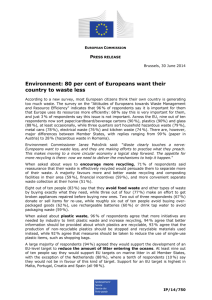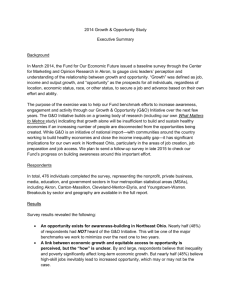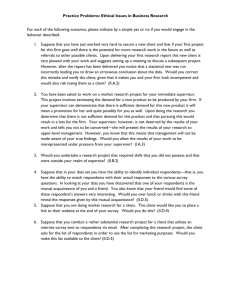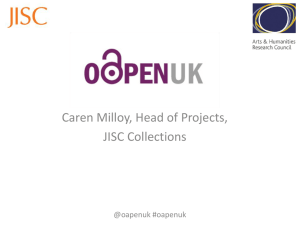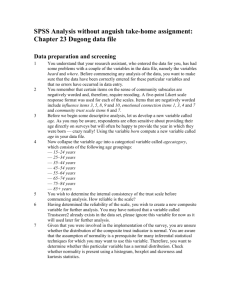Click to View
advertisement
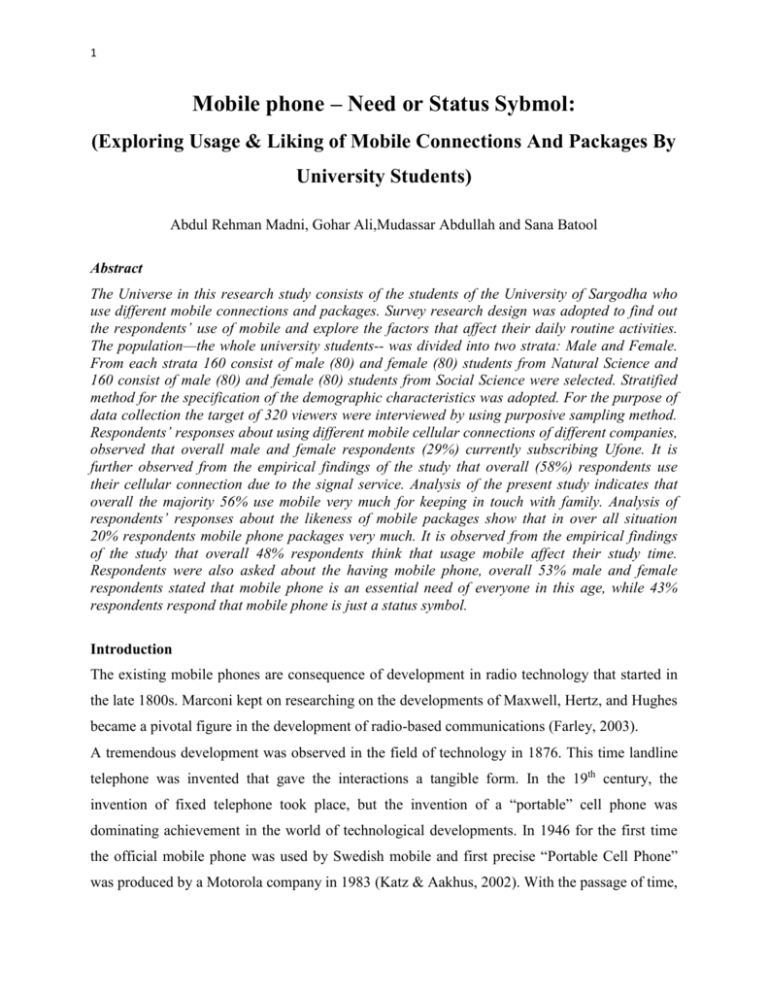
1 Mobile phone – Need or Status Sybmol: (Exploring Usage & Liking of Mobile Connections And Packages By University Students) Abdul Rehman Madni, Gohar Ali,Mudassar Abdullah and Sana Batool Abstract The Universe in this research study consists of the students of the University of Sargodha who use different mobile connections and packages. Survey research design was adopted to find out the respondents’ use of mobile and explore the factors that affect their daily routine activities. The population—the whole university students-- was divided into two strata: Male and Female. From each strata 160 consist of male (80) and female (80) students from Natural Science and 160 consist of male (80) and female (80) students from Social Science were selected. Stratified method for the specification of the demographic characteristics was adopted. For the purpose of data collection the target of 320 viewers were interviewed by using purposive sampling method. Respondents’ responses about using different mobile cellular connections of different companies, observed that overall male and female respondents (29%) currently subscribing Ufone. It is further observed from the empirical findings of the study that overall (58%) respondents use their cellular connection due to the signal service. Analysis of the present study indicates that overall the majority 56% use mobile very much for keeping in touch with family. Analysis of respondents’ responses about the likeness of mobile packages show that in over all situation 20% respondents mobile phone packages very much. It is observed from the empirical findings of the study that overall 48% respondents think that usage mobile affect their study time. Respondents were also asked about the having mobile phone, overall 53% male and female respondents stated that mobile phone is an essential need of everyone in this age, while 43% respondents respond that mobile phone is just a status symbol. Introduction The existing mobile phones are consequence of development in radio technology that started in the late 1800s. Marconi kept on researching on the developments of Maxwell, Hertz, and Hughes became a pivotal figure in the development of radio-based communications (Farley, 2003). A tremendous development was observed in the field of technology in 1876. This time landline telephone was invented that gave the interactions a tangible form. In the 19th century, the invention of fixed telephone took place, but the invention of a “portable” cell phone was dominating achievement in the world of technological developments. In 1946 for the first time the official mobile phone was used by Swedish mobile and first precise “Portable Cell Phone” was produced by a Motorola company in 1983 (Katz & Aakhus, 2002). With the passage of time, 2 the use of mobile phone proves to be very penetrating. Researchers showed that there were one billion mobile phone users in 20 years after its invention, but the unbelievable fact is that 1 billion more wear accumulated just in 40 months (James & Drennan, 2005). According to an estimate, at the end of 2011, there were 6 billion mobile subscriptions, throughout the world which is equal to 87% of the world population. This is a tremendous increase because in 2010 and 2009 subscription was 5 billion and 4.7 billion successively. In the developed countries, mobile phone subscription has achieved its saturation point, at least one phone subscription per person. This shows a marked growth is being driven by developing demands, especially due to increased use of cell phones in Indian and Chinese populous nations. In the developing nations, at the end of 2011, mobile subscription was 76% that is 79% now and this ratio in Africa is 53% the lowest in the world (Ijaz, 2013). Portio research in the excellent free mobile fact book 2012 estimate that throughout the world, mobile subscription may reach 6.5 billion by the end of 2012, 6.9 billion by the end of 2013 and 8 billion at the end of 2016. All over the world the number of connections on mobile phone networks has crossed 4 billion and is estimated to reach 6 billion by 2013 (Mika, 2012). In Asian business, the cellular phone industry is one of the rare bright spots. Pakistan is the 8th largest country of the world regarding mobile phone users and total number of mobile phone is 119,860,799 and the population is 178,854,781 so we can say that 68.60% population is using the mobile phone. In Pakistan 44% users use mobile phone for text messaging, 9% for watching videos and 6% for using the internet (Sohail, 2010). Along with technical developments, since early 1980, the number of mobile phone users is increasing dramatically. In spite of international economic recession, the mobile phone sector does not seem to be endangered. In response to economic depression customers will buy cheap cell phones (Medford, 2008). At the end of March 2012, according to a statistical report of Pakistan Telecommunication Authority, Mobilink Telecom Company has maximum 35.8 million customers, Telenor at second position, having 29.35 million subscribers, Ufone having 23.12 million subscribers at third position and followed by Zong with 15.66 million subscribers and at the and Warid with 14.40 million (PTA, 2012). In March 2012, Warid succeeded to have 14.40 million subscribers by adding 296,510 users in the month. In March 2012, Zong and Ufone succeeded to convince more 711,609 and 697,388 new customers respectively. Half a million subscribers selected Telenor as their communication source while 491,321 subscribers liked to join Mobilink. So Zong once again 3 succeeded to win the race on March 2012. It can be said that Warid seems to be keeping up with the process of cleaning the data and reported a negative addition of 296,510 subscribers in the month (Mohammad, 2013). Market research shows that recently mobile phone teledensity has reached 62.5% from just 3.3% in 2004. More than 10,000 cities /towns/villages and almost 92% of the land area have been provided with cellular services. Regarding revenue collecting status Mobilink is the leader followed by Telenor, while Ufone, Warid and Zong have third, fourth and fifth positions respectively. In Pakistan, use of cellular services is increasing rapidly. It is revealed by facts and figures that Pakistan has 53 million mobile youth owners will be half of the total strength of subscribers in 2012. So the mobile youth market is getting saturated in Pakistan. In 2008 mobile youth penetration in Pakistan for the 25-29 age groups reached beyond 100%, while the 26-24 age group crossed the same limit in 2009. Mobile youth revenues were $1.6 billion in 2011 which may reach to $1.8 billion in 2012 (Niaz, 2012). Objectives of the Study To explore the consumption patterns of Mobile connections by Students. To dig out purpose of using mobile by Students. To explore the consumption patterns of Mobile Packages by Students. To determine the extent of liking in the Mobile Packages by Students. To find out the effects of the Mobile and packages on the daily routine activities of Students. Literature Review Because of rapid communicating sources world has adopted the form of a global village. Telecom sector has changed communication set up everywhere and this is one of the most discussed topics in Pakistan, now a days. Since last few years, telecom sector is one of the emerging sectors in Pakistan and is attracting many new investors (Butt, 2006). In Pakistan, mobile phones are in easy access to everyone because of competitive atmosphere among companies of both services providers and phone set providers. Due to this increasing demand for cell phones, companies are investing abundantly in this sector. Now-a-days, Mobilink, Telenor, Ufone, Zong, and Warid are five major functioning companies in Pakistan (Sargana, 2006). While discussing the term marketing, Winer (2001) is of the view that for developing long term relations with the customers and for earning maximum profits for the company, it is necessary to perceive the needs and desires of the customers precisely. For long term success of a company, it 4 is significant to spot the elements which may prove helpful to retain maximum consumers. In the current scenario, when industries and companies are facing competition threats, it is very necessary for them innovative and should explore new horizons to achieve competitive preference over the competitors (Morgan & Haunt, 1994). Research findings of Grant & O’Donohoe, (2007) regarding use of mobile phones by youth shows that mobile phone performs a pivotal role in developing social activities of young people. According to different theories, the advertisements may be of two types, one with high viewer’s involvements and one with low viewer’s involvements. Implying social adoption theory the information is basically processed in the same manner for both high and low viewers of advertisements, with a minor difference that the information processed to low viewers advertisements ends quickly rather than others. Social adoption theory as it suggest the message transferred from the image of the model person and the product should come to gather to make advertisements effective. Grant (2007) says that youngsters not only keep mobile phone as a fashion item, but they use it as a multi-functional instrument. They use it for downloading videos, songs, pictures, and surfing the internet. Short Message Service (SMS) causes maximum interaction among students, which may promote fruitful learning in classrooms and lectures (Markett, Sanchez, Weber & Tangney, 2006). Mobile phone technology provides opportunity for students to share their experiences with their family members and to remain in contact with them. So they have a chance to play their specific role in family affairs and are able to receive psychological and emotional support from the family members at different occasions (Chen & Katz, 2007). In spite of many positive aspects of mobile phone technology, some researchers have also highlighted negative prospects of the device. Due to excessive use of mobile phone, youngsters have to face different problems like emotional stresses, financial crisis, less attention to academics and disruptions in relations (Bianchi & Phillips, 2005). Metthews (2004) claims that average calling rate of a youngster is five calls per day and most of them 85% avail SMS service even for less than five times per day. Youngsters making excessive use of mobile phones are vulnerable to serious social, health and academic problems. Youngsters usually do not make careful use of their cell phones, especially while driving they are at serious safety risk (McEvoy et al, 2005). 5 Methodology The Universe in this research study consists of the students of the University of Sargodha who use different mobile connections and packages. Survey research design was adopted to find out the respondents’ use of mobile and explore the factors that affect their daily routine activities. The population—the whole university students-- was divided into two strata: Male and Female. From each strata 160 consist of male (80) and female (80) students from Natural Science and 160 consist of male (80) and female (80) students from Social Science were selected. Stratified method for the specification of the demographic characteristics was adopted. This approach adequately organized the population into heterogeneous subsets and selected various elements from each. For the purpose of data collection the target of 320 viewers were interviewed by using purposive sampling method. A questionnaire is formulated. Face to face procedure was adopted and all the respondents were contacted personally. Findings In the modern-day life, the mobile phone is playing an incredible role in providing information about every field of life round the clock. Mobile phones have become an essential thing for daily work and development, but there are a great majority of people who use mobile but actually they do not need such device, they just use for fun and entertainment. Mobile phones have great impact on almost every segment and portion of society, especially they are affecting students very much. Figure 1 Connections that are Subscribing Currently 6 Respondents’ responses about using different mobile cellular connections of different companies, observed that overall male and female respondents (29%) currently subscribing Ufone followed by Mobilink (27%), Telenor (24%), Warid (12%) and Zong (8%). Comparative analysis of the empirical findings indicates that (30%) male respondents are currently using Mobilink followed by Ufone (26%), Telenor (23%), Warid (17%) and Zong (4%). Female respondents (30%) subscribe Ufone followed by Telenor (23%), Mobilink (22%), Warid (14%) and Zong (11%) (Figure 1). It is further observed from the empirical findings of the study that overall (58%) respondents use their cellular connection due to the signal service while (51%) respondents are those who use their connections only for SMS packages. The findings further indicate that (59%) male respondents prefer to use their connections due to good signal services; while (54%) female are those who prefer their cellular connections due to the cheap call rates as compared to the male members who are (44%). Outcomes of the study also indicate that same number of male and female (57%) respondents use their connection because of Peers. Female respondents who significantly like to use very much their connections only for the purpose of the messages (Table 1). Table 1 Reason of Using Connection Signal Service Very much Much Somewhat Little Not at all Packages / Call Rates Very much Much Somewhat Little Not at all Because of Peers Very much Much Somewhat Overall Male Female 58* 18 9 8 8 59 15 11 7 7 57 20 6 9 9 49 27 11 8 6 44 27 11 9 9 54 26 11 6 3 26 21 22 24 21 21 28 21 23 7 Little Not at all Only for SMS Very much Much Somewhat Little Not at all 18 13 18 16 17 10 51 21 12 12 5 44 24 13 11 8 57 17 10 13 2 -------------------------------------------------------------------*: Figures showing percentage The purposes behind using the mobile phone vary in terms of male and female. Overall, male and female respondents presented their point of view about the usage of mobile phone for different purposes, including getting information; keep in touch with family, because of their peers, for entertainment and for browsing internet. Analysis of the present study indicates that overall the majority 56% use mobile very much for keeping in touch with family, 40% male and female respondents stated that they use mobile for getting information (Table 2). Table 2 Purpose behind Using Mobile Phone For Getting Information Very much Much Somewhat Little Not at all To Connect with Family Very much Much Somewhat Little Not at all Because of Peers Very much Much Somewhat Overall Male Female 40* 21 16 13 10 33 22 17 13 14 47 20 15 13 5 56 25 9 6 4 47 29 13 7 5 66 21 5 5 3 22 30 21 19 28 25 25 32 18 8 Little Not at all For Fun / Entertainment Very much Much Somewhat Little Not at all For Browsing Very much Much Somewhat Little Not at all 15 11 15 13 15 10 28 30 18 15 9 24 29 21 14 11 32 31 15 16 7 16 21 21 25 17 17 15 21 29 17 14 27 21 21 17 -------------------------------------------------------------------------------------*: Figures showing percentage According to the empirical finding of the study (47%) females use mobile phone very much to get all kinds of information while only 33% males used for the same purpose. Respondents’ responses further reveal that 66% females are those who use more mobile to keep in touch with their family members as compared to males (47%). The present study further reveals that in the case of entertainment and contact with peers shows no significant difference in their response categories of both male and female (Table 2). 9 Figure 2 Extent of Likeness Mobile Packages Analysis of respondents’ responses about the likeness of mobile packages show that in over all situation 20% respondents mobile phone packages very much, the major portion of respondents (26%) like mobile packages somewhat. Furthermore, 13% respondents respond that they do not like mobile’s call and message packages. Comparison of the study further indicates that 27% males are those who like the mobile packages very much, while 24% female like packages very much. Furthermore, results of the study show that 19% female do not like mobile packages as compared to male respondents (8%) who also do not like mobile phone’s call, message and other packages (Figure 2). Mobile usage largely affecting the different activities of the people, including sleeping time, study time, sports, eating habits and meeting with friends. It is observed from the empirical findings of the study that overall 48% respondents think that usage mobile affect their study time, 42% respondents consider mobile usage of their disturb sleeping time and 29% stated that meetings with friends are affected by using mobile. The analysis further indicates that 49% females are those who presented their perceptions about the influence on study time through mobile and 47% male respondents also have the same perception (Table 3). 10 Table 3 Effects of Mobile Usage on Daily Routine Activities Sleeping Time Very Much Much Somewhat Little Not at all Study Time Very much Much Somewhat Little Not at all Sports Very much Much Somewhat Little Not at all Eating Habits Very much Much Somewhat Little Not at all Meeting with Friends Very much Much Somewhat Little Not at all Overall Male Female 42* 18 12 16 11 37 15 15 19 14 48 22 9 13 7 48 25 11 10 6 47 24 13 9 7 49 27 9 11 4 19 21 23 18 18 19 24 29 13 15 19 19 17 23 22 23 22 20 22 12 26 17 23 22 12 20 28 17 22 13 29 24 17 14 16 24 24 18 17 17 34 25 15 12 14 -----------------------------------------------------------------------------------*: Figures showing percentage To explore the effects of mobile usage on different types of social interaction patterns, according to the perception of the overall respondents mobile usage largely affected the interaction patterns with Parents, Friends, Teachers, Peers and Relatives. It is further observed that overall majority of the respondents (51%) thinks that mobile usage affect their level of interaction with friends very much. 24% respondents consider that mobile usage disturb their 11 interaction pattern with Parents very much and same number of respondents also think that mobile usage is disturbing their interaction level with relatives very much. The comparative analysis of the study further reveals that both male (43%) and female (58%) respondents think that mobile usage is overcoming their interaction with their friends (Table 4). Table 4 Effects of Mobile Usage on Social Interaction Over All Male Female Very Much Much Somewhat Little Not at all 24* 32 20 17 7 22 29 26 15 8 26 35 15 18 6 Very Much Much Somewhat Little Not at all 51 27 10 6 6 43 27 18 5 7 58 27 3 8 4 Very Much Much Somewhat Little Not at all 13 22 25 30 10 14 25 27 27 7 12 19 24 33 12 Very Much Much Somewhat Little Not at all 15 26 18 23 19 16 25 17 22 19 13 27 19 23 18 Very Much Much Somewhat Little Not at all 24 31 21 14 10 20 28 26 15 11 28 35 15 13 9 Parents Friends Teachers Peers Relatives ---------------------------------------------------------------------*: Figures showing percentage 12 Figure 3 Mobile -- Need or Status Symbol Respondents were also asked about the having mobile phone, overall 53% male and female respondents stated that mobile phone is an essential need of everyone in this age, while 43% respondents respond that mobile phone is just a status symbol and in reality people have no need of it. In comparison index 64% male respondents consider mobile phone a need, 58% females also think same. More female respondents (37%) consider a mobile phone as a symbol of status than male respondents (35%) who think about mobile a status symbol (Figure 3). Conclusion The Universe in this research study consists of the students of the University of Sargodha who use different mobile connections and packages. Survey research design was adopted to find out the respondents’ use of mobile and explore the factors that affect their daily routine activities. In the modern-day life, the mobile phone is playing an incredible role in providing information about every field of life round the clock. Mobile phones have become an essential thing for daily work and development, but there are a great majority of people who use mobile but actually they do not need such device, they just use for fun and entertainment. Mobile phones have great impact on almost every segment and portion of society, especially they are affecting students very much. Respondents’ responses about using different mobile cellular connections of different companies, observed that overall male and female respondents (29%) currently subscribing Ufone followed by Mobilink (27%), Telenor (24%), Warid (12%) and Zong (8%). It is further 13 observed from the empirical findings of the study that overall (58%) respondents use their cellular connection due to the signal service while (51%) respondents are those who use their connections only for SMS packages. Analysis of the present study indicates that overall the majority 56% use mobile very much for keeping in touch with family. According to the empirical findings of the study (47%) females use mobile phone very much to get all kinds of information while only 33% males used for the same purpose. Analysis of respondents’ responses about the likeness of mobile packages show that in over all situation 20% respondents mobile phone packages very much. Mobile usage largely affecting the different activities of the people, including sleeping time, study time, sports, eating habits and meeting with friends. It is observed from the empirical findings of the study that overall 48% respondents think that usage mobile affect their study time. It is further observed that overall majority of the respondents (51%) thinks that mobile usage affect their level of interaction with friends very much. Respondents were also asked about the having mobile phone, overall 53% male and female respondents stated that mobile phone is an essential need of everyone in this age, while 43% respondents respond that mobile phone is just a status symbol. About the Author Abdul Rehman Madni is Teaching Assistant, Deptartment of Communication studies,University of Sargodha, Sargodha, Pakistan. Gohar Ali is M.Phil Scholar in Deptartment of Communication studies, University of Sargodha, Sargodha, Pakistan. Mudassar Abdullah is M.Phil Scholar in Deptartment of Communication studies, University of Sargodha, Sargodha, Pakistan. Sana Batool is Teaching Assistant in Deptartment of English, University of Sargodha, Sargodha, Pakistan. 14 References Bianchi, A., and Phillips, J. (2005). Psychological predictors of problem mobile phone use. Cyber Psychology & Behaviour. Butt, S. A. (2006). Growth of Mobile Phone in Pakistan. Department of Communication Studies, Bahauddin Zakariya University, (Unpublished Masters Thesis). Chen, Y. & Katz, J. E. (2007). Extending Family to School Life: College Students ‟Use of Mobile Phone. Paper presented at the annual meeting of the International Communication Association, TBA, San Francisco. Retrieved on January 02, 2011, from www.allacademic.com/meta/p171018_index.html. Farley, T. (2003). “Mobile telephone history”. www.privateline.com/PCS/history.htm. Grant, I. & O'Donohoe, S. (2007). Brand in the hand or sand in the hand? A Contextualized account of adolescents' mobile phone consumption. Proceeding of Advances in Consumer Research, North America. Ijaz, O. (2013).Competitive Trends, Marketing, Mobile Companies, Mobile Trends, Mobilink, Pakistan, Telenor, Ufone, Warid, Zong’. Department of Communication Studies, University of Sargodha.(Unpublished M.Phil Thesis). James, D., & Drennan, J. (2005). Exploring Addictive Consumption of Mobile Phone Technology, ANZMAC 2005 Conference: Electronic Marketing. Retrieved on January 21, 2011, fromhttp://smib.vuw.ac.nz:8081/WWW/ANZMAC2005/cd-site/pdfs/12ElectronicMarketing/12-James.pdf. Katz, J. E. & Aakhus, M. (2002). Introduction: framing the issues IN: Katz, J. E. & Aakhus, M. (eds.) Perpetual Contact: Mobile Communication, Private Talk, Public Performance. Cambridge: The Press Syndicate of the University of Cambridge. Markett, C., Sánchez, I. A., Weber,S., Tangney, B. (2006). Using short message service to encourage interactivity in the classroom. Computers & Education, 46 (3), 280-293. Matthews, R. (2004). The Psychosocial aspects of mobile phone use among adolescents. Asian Journal of Analytical Research. McEvoy, S. P., Stevenson, M. R.., McCartt, A.T., Woodward, M. Haworth, C., Palamura, P., and Cercarelli, R. (2005). Role of mobile phones in motor vehicle crashes resulting in hospital attendance: A case-crossover study, British medical Journal. Retrieved on January 08, 2011, from www.press.psprings.co.uk/bmi/july/mobilephones.pdf . Medford, C. (2008). Mobile phone industry to weather economic woes: Red Herring, 6. Mika, N. (2012). Number of mobile phone connections tops 4 Billion: PC. Magazine. Mohammad Yusha. (2013), why are advertisements-by cell phone companies in Pakistan targeted by the public. Department of Media Studies, The Islamia University of Bahawalpur, Pakistan (Unpublished M.Phil Thesis). Morgan, Robert M., Shelby D. Hunt. (1994), “The Commitment-Trust Theory of Relationship. Eadwell. Niaz, U. (2012). Addiction with Internet and Mobile: An overview. Journal of Pakistan Psychiatric Society, 5(2), 72. PTA History, (2012), Pakistan Telecommunication Authority, Available from www.pta.ires.com /index.php?cur_t=vnormal&option=com_content&task=view&id=358&Itemid=320&bol d=p Sargana, M.A, 2006, Recent Growth trends in the telecom sector of Paksitan. Communication Today. 15 Sohail, Kamran (2010), Mobile Phone: Calling and Texting Patterns of College Students In Pakistan, in international Journal of Business and Management. Winer, R. S. (2001), “A framework for customer relationship management,” California Management Review.




